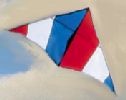|
DELTA Flying Tips:
Flying your delta the first time, you may find it very helpful to follow the following tips.
Shipping & Transport of your Delta:
For the purpose of packing, a delta kite which has a single piece leading edge (one piece rod in each leading edge), the leading edge rods usually are slid all the way to the nose of the kite. This allows for a smaller package for transport and shipment of the kite.
Leading Edge Rod adjustments for your Delta:
For flying in the kite normal wind range, the flier should slide leading edge rods all the way to the trailing edge of the kite. To slide the rod within the leading edge, grasp the upper part of the pocket with one hand, grasp the lower half of the rod with the other hand and bunch up the fabric from lower end towards the upper end, then while holding firmly on the lower end, pull the fabric at the nose (hence sliding the rod within the leading edge pocket, downward towards the trailing edge). Repeat this several times until the leading edge rod is all the way at the very lowest end of the pocket (that meets the trailing edge). This will allow the full sail of the kite to catch the wind when flying. Make sure that both left and right leading edge rods are installed (or slid) all the way to the lower end of the leading edge pockets.
Installing your Leading Edges (if not pre-installed):
If your delta does not have it's leading edge rods installed within the sail of the kite, place the front side of the kite, with it's keel face down. The keel is the triangular flap attached to the front of the kite, which is where the flying line is to be attached. On the back side you will find the openings to install the leading edges into the sail.
Cross Spreader:
Your Delta comes with one Cross Spreader, which you need to install. Simply open the kite to it's full wingspan, place the front of the kite face down. You will see that there are two pockets sewn to the back of the kite which their openings face the center spar. These pockets are about one third of the way down from the top part of the leading edge. Place one end of the cross spreader into one pocket, then bow the cross spreader sufficiently to allow the other end of the spreader to be placed into the opposite pocket. You kite is now almost ready to fly!
Flying Line:
If your kite did not come with flying line, make sure that you fly on line that is has the minimum strength (or test line) that is recommended by the manufacturer of the kite. Attach your flying line firmly to the keel of your delta. The best way to attach your line is by tying a pigtail measuring several inches long, and attach the pigtail using a larkshead knot to the keel. Then tie a loop on the end of the line (from your winder or spool), and use a larkshead to attach your line to the pigtail on the keel. You are now ready to fly.
Self Launching your Delta:
To fly your delta, you can usually self launch. Let out a few feet of line, then while holding the winder with one hand, hold the keel and raise the kite. Your delta should catch the wind and you can let out line as the wind takes your delta up into the air.
Assisted Launching of your Delta:
On a light wind day, it may be helpful to have a friend assist you in launching your kite. To use this method, let out 50 -70' of line before launching. have your friend hold your kite, bring the line taught and give a pull on the line, at the same time telling your friend to release the kite.
Ground Stake, or Anchor Launching of your Delta:
WARNING: This method should only be used by experienced kite fliers, who are totally aware of their surroundings within the perimeter of the flying area. Make sure when stake or anchor flying, the kite will be clear of all obstructions within a 360 degree radius from the anchor. Example: If flying on 500' of line make sure that your kite has clear area measuring 500', in all directions from the anchor (360 degrees from the anchor). If the wind changes direction at all, your kite will collide with anything within it's path (trees, power & telephone lines, cars, buildings etc.). You may use a ground stake of some type to tie your line to, but make sure that the stake is heavy enough for the size kite you are flying. If not using a stake you can use some other type of anchor (i.e. picnic table, fence post, etc.). Determine what you will be using as your anchor will support the pull that your kite can generate (large kites can create tremendous pull in higher winds).
To use this method: Walking straight down wind from your anchor, determine the length of line you wish to fly your kite on. Start unwinding line, laying the line on the ground as you unwind, and walk back to your ground stake (or anchor). Once at your ground stake use a several larksheads, a double larkshead, half hitch (or similar type knot), to tie your line to the anchor. Then go back to the end of the line, that you started laying, and fasten your kite to the line. Tighten the line by walking away from the anchor, gentle lift the kite with nose up, and let the kite take off.
Storing your Delta after flying:
For break down of the kite after flying, it is best to always slide the leading edge rods all the way to the nose of the kite. This allows for a smaller package for transport and shipment of the kite. You just need to slide the Leading edge rods which are inserted into sleeves (or pockets) in edge leading edges.
NOTE about Large Deltas: In the case of a large wing delta kite, the kite may come with a two piece leading edge, which must be assembled then installed into the leading edge (sometimes extremely large deltas have three section leading edges).
CAUTION when flying Deltas: If flying your delta in higher winds (towards to top end of it's rated wind range), the leading edge rods can be slid all the way to the nose, hence there is less sail catching the wind, and less stress on the frame of the kite. If your frame seems to be distorting too much (leading edge bending to the extreme), then you are probably flying in higher winds than the kite is meant to fly in. If the frame of the kite fails because of excess stress, you most likely will not be able to control the kite, and the kite may crash (possibly causing damage to people and property).
ADDITIONAL Delta HINTS:
Delta tilts to one side, spins, and or dives:
If one leading edge rod is higher than the other (say the right LE rod is 2" higher, or above the end of the pocket), then your delta may have a tendency to tilt or spin to one side. If both leading edge rods are slid all the way to the bottom of the leading edge pockets, and the delta wants to tilt to one side or spin, then try raising the LE rod on the side that the kite wants to spin (if it is spinning to the right, raise the right LE rod slightly). If it still spins to the right (raise the right rod a little more), repeat until the kite flies stable (without spinning, or diving). If the kite still turns, spins or dives uncontrollably, then perhaps you are simply trying to fly the kite beyond it's upper wind range.
Adding a TAIL to a Delta:
Most of the time, most deltas can be flown without a tail. Sometimes though, depending on the wind conditions (especially in higher, or turbulent winds), it helps to add a tail to help steady the kite. Smaller deltas usually have one tail attachment point, in the center (spine), on the trailing edge. Larger deltas may have three or more tail attachment points (or loops), one in the center, one of each wing tips, and sometime elsewhere on the trailing edge). If one tail is attached, it should be at the center attachment point. If more than one, they should be attached at same points right and left, plus center point if you wish.
Replacing broken leading edge rods in a Delta:
All deltas have openings on the back side within the leading edges, usually towards the trailing edge (bottom of the kite). This opening allows for the leading edge rod(s) to be installed, and also for replacement if the leading edge rod should break and need replaced.
|
.gif)
.gif)
.gif)
.gif)


